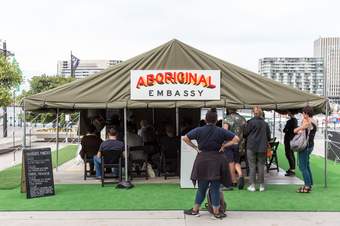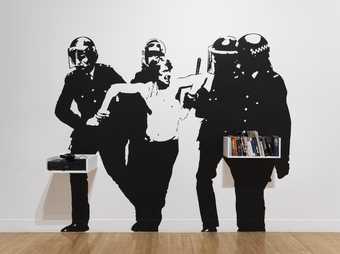A protest is a way of saying "NO!" - that you really disagree with something or someone. When artists create an artwork with this message in mind, we call this protest art. It could be anything - from drawing to performance, and can inspire others to think differently or create changes in society.
Here are four reasons why an artist might make protest art:
1. art gives us a voice
Richard Bell is an artist from Australia. He is a member of the Kamilaroi, Kooma, Jiman and Gurang Gurang communities. In 2013, he set up a tent in Melbourne where people could go to listen to Aboriginal histories and reflect on the past. He called this artwork Embassy in honour of another tent set up 40 years earlier by four young activists who wanted the government to give back land to Indigenous communities. Their tent was a space where they could stand up for themselves, because the people in power did not. Now, Embassy has travelled all over the world!

Richard Bell Embassy 2013-ongoing. Installation view, 20th Biennale of Sydney, MCS, 2015. Image courtesy of the artist and MCA. Copyright: The artist. Photograph: Daniel Boud
2. art shows us where we can change
Faith Ringgold is an African-American artist who uses art as a way of recording moments in cultural history and sharing people’s stories. Her American People series, which she painted in the 1960s, was a response to the civil uprisings that were happening at the time - a lot of which weren’t being shown in the newspapers. Faith and her friends were part of a group of artists recording the movement in their art. By documenting difficult times, we can speak truth to power and say ‘NO!’ to important things being ignored
3. art helps us understand
Jeremy Deller is an English artist who likes to ask questions about why different events happen. His artwork The Battle of Orgreave Archive (An Injury to One is an Injury to All) was a re-enactment of a real event that happened when Jeremy was growing up. On 18th June 1984, 8,000 miners and 5,000 police officers clashed in Orgreave, in the north of England over the closing of the local steel plant. Many people worked at the plant and closing it meant some didn't have a way to support their families anymore. Jeremy wanted to understand this event and make sure it would never be forgotten! So, he invited over 800 people to re-enact it. Some of the people were actors, others had survived the real fight 17 years ago His artwork is a way to revisit the past and, by facing it again, understanding it and hopefully changing things for the better.

4. art brings people together
Tania Bruguera is a Cuban artist who likes involving other people in her art. In 2018, she invited people who worked or lived near Tate Modern to be part of a group where they could talk about the museum. How could it listen better to the community, what changes needed to happen? Together, they decided that Tate Modern should rename one of its buildings after a local neighbour and activist, Natalie Bell. For Tania, there is no authority so large that you cannot say “NO!” to it. But things can only change when you speak up and act!

